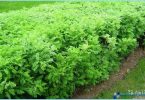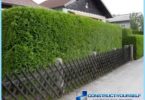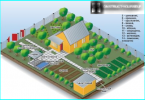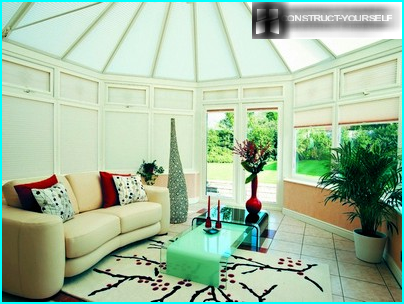
The owners of suburban areas are increasingly in the regeneration areas use wide rolls of geotextile fabric. What kind of material and for what purpose it is used? Try to understand. Non-woven material made of woven synthetic polymer fibers, and has excellent quality characteristics: it is wear-resistant and does not rot. Thanks to the optimal combination of characteristics of the geotextile is convenient to apply in many spheres of human activity or land use, construction, landscape design.
The contents
The types of geotextiles and its characteristics
Depending on the manufacturing techniques are distinguished:
- Needle-punched geotextile – is created by pulling with the help of a serrated needle, binding thread through the base. He has excellent strength and excellent permeability, and is widely used when constructing drainage systems.
- Thermally bonded geotextile – made under the influence of heat treatment of a cloth in which the synthetic fibers melt and more rigidly fastened together. It is characterized with dense structure, high tensile strength, but lower filtration qualities.
Thanks to special technology, the geotextile has a number of indisputable advantages, the main among which are:
- Environmentally friendly. Geotextiles are not degradable chemical components thereby causing harm to human health and the environment.
- Strength. Non-woven material resistant to mechanical damage, puncturing and tearing loads. Significant elongation of the material before breaking, which occurs due to the infinite length of the threads virtually eliminates damage while styling.
- Resistance to environmental influences. He does not get a not silting and does not rot, resistant to UV, acids, alkalis and organic substances.
- The ease of installation. The material is produced as small and light bales that are convenient to transport and, if necessary, cut it in half with an ordinary hand saw. The material in the process of applying is easy to cut with a knife or scissors.
- Economical in price. With excellent quality characteristics, the cost of geotextiles is quite low, so they are widely used in the construction industry and for domestic use in the regeneration of suburban areas.
Possible applications of the material are striking versatility of AGROSALON. With the release of new grades of geotextiles range of material is constantly growing.
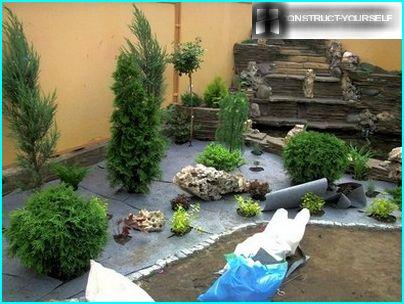
Geotextile refers to the number of environmentally friendly materials: under the action of UV radiation does not form any by-products
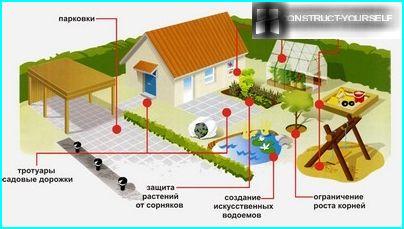
Thermally bonded geotextile used in road construction, agriculture, strengthening of slopes and banks of reservoirs
How to apply a geotextile at the site?
The geotextile allows to implement on the site any ideas geoplastics the transformation of the landscape. Using non-woven material, you can create a new design of the composition, transforming the appearance of the area.
Option #1 — improve the quality of garden paths
It’s hard to imagine the area without escaping into the garden of twisting paths. When planning their arrangement, we always want the result is beautiful and functional landscaping element that regularly serve more than one season.
The use of AGROSALON allows you to keep the decorative effect and prolong the service life of the garden paths. Even the device on the small area of the track requires a lot of trouble: soil excavation, backfilling of the underlying «pillow», laying of the coating. But in the process of operation, when the layers of gravel or sand gradually gives way in the ground, on the surface of the track begin to appear cavities, the bumps and irregularities.
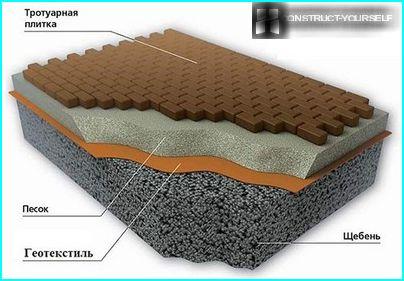
A layer of geotextile laid between the soil and gravel bed allows even load distribution and to prevent mixing of the layers
It is convenient to use non-woven material and in the regeneration of sandy tracks, gravel sites. Laid between the soil and sediment with geotextile material optimizes the seal so that the bulk material does not penetrate the soil. And it would contribute significantly to reducing the consumption of the bulk material and hence total savings. In addition, the canvas will contribute to the rapid outflow of water and prevent the germination of weeds and grasses. In the swampy and soft ground areas of the nonwoven material and does function as a solid reinforcement.
Option #2 — waterproofing of artificial lakes
Decorative ponds – a popular landscape design elements. The arrangement of any of them, whether it be a small lake and a large swimming pond, assumes the presence of special waterproofing bowls.
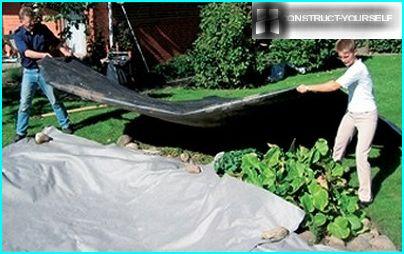
During the construction of the reservoir the bottom of the pit is often lined with a layer of gravel or sand, on top of which is laid waterproofing material
In the process of operation and cleaning of the reservoir, there is always the possibility of damage to the material roots of plants or the same stones. And the use of geotextiles will help to simplify life. Enough to pave agrotextile under the insulation layer, so as not to worry more about protecting the material from external damage.
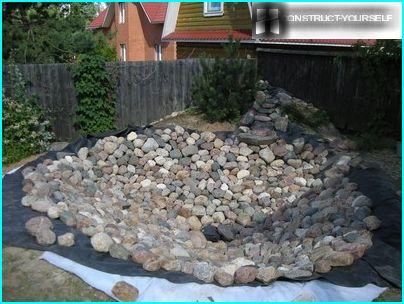
If the geotextile is to lay the second layer on top of waterproofing material, the bottom of the reservoir and does it is safe to put and place river stones
Option #3 — development of the adjoining territory
Agricultural fiber can be used to create open areas, rock gardens design. The construction on the plot of today’s popular patio with wooden decking and flooring also does not do without use of geotextile. It lay as a ground base to eliminate the possibility of germination through the boardwalk weeds.

Material, allowing the soil to breathe and have the ability to freely absorb moisture, act as a reliable protection of terraces or platforms for a summer kitchen from the penetration of pesky ants and rodents
With the help of the geotextile it is easy to divide and to construct a high embankment, to strengthen the surface and to reinforce the soil, drain the soil and provide enough filtration.
Laid under the sod cloth would ensure the diversion of rainwater, preventing erosion and significantly strengthening the slopes of the rough surface. Also, geotextiles and indispensable in the regeneration of playgrounds.
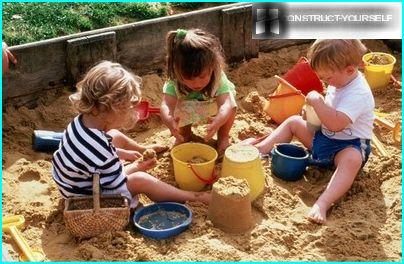
In the manufacture of children’s sandbox that the sand is not stomped into the ground and not mixed with the earth, it is only necessary to cover the bottom of the pit with a layer of geotextile
Option #4 — construction of foundations and retaining walls
The strength and durability of any construction depends on the reliability of its Foundation. If to speak about concrete types of foundations, considerable damage to them causes a capillary wetting groundwater. Thermally bonded geotextile is used to improve the waterproofing of monolithic foundations.
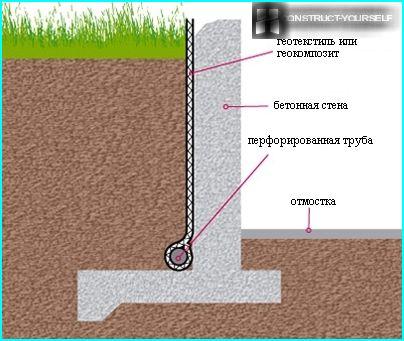
In the construction of foundations geotextile is used for separation of fine-grained soil and gravel backfill so as to prevent mixing of the layers, however, and the capillary wetting of the walls
The material can simultaneously perform two functions: to separate the layers, and to provide effective drainage, preventing prolonged contact of the surface of the concrete Foundation with moisture.
Option #5 — green roof
Popular today «green» the roof also cannot do without the use of non-woven material.
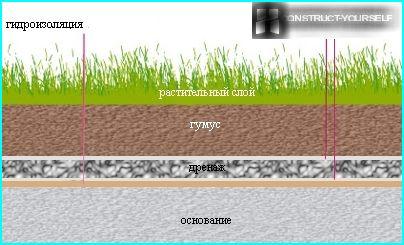
To prevent mixing of the layers agrotextile navigate between the drain layer and humus and to protect the roof over waterproofing
And when building inverted roofing material is used to prevent leakage between the plates of insulation ballast material. For these purposes it is placed on top of the insulation layer.
The use of AGROSALON in horticulture
Versatile material opens up incredible opportunities for gardeners. Applying agrotextile, you can ease the process of growing crops, increase yields and, in parallel, to solve many of the associated tasks.
Weed control is an annual challenge for many gardeners. Applying agrotextile you can significantly reduce the volume of work. Preventing the growth of weeds, the canvas will fully provide access to water, and with it the fertilizers and herbicides to the roots of garden plants.
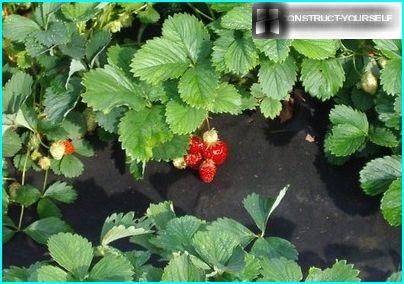
Planting cultivated plants in done in the canvas holes, you provide the plants a comfortable environment for development, and save yourself from the time-consuming weeding
It is no secret that many ornamental plants «fussy» in nature. They require special care, preferring a special soil composition, which often differs from the prevailing portion of the soil.
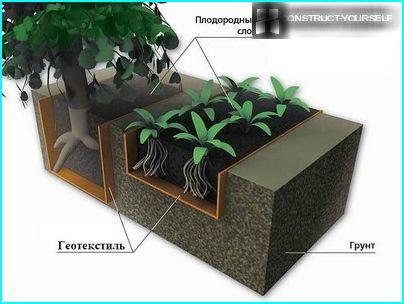
To distinguish between different types of fertile soil, creating a makeshift «pockets» for the planting of certain varieties, you can use the same geotextile
The creation of an artificial landscape in depleted soils requires the arrangement of fertile soil, which under natural conditions is washed out in more thin layers. Additional layer of fabric will prevent the contamination of infertile soils and their leaching. Due to the non-woven fabric plant roots will not grow in barren soil.
Seasonal night frosts also poses a great danger to plants. Help out in the hot summer months, covering a tender leaves from the scorching sun.
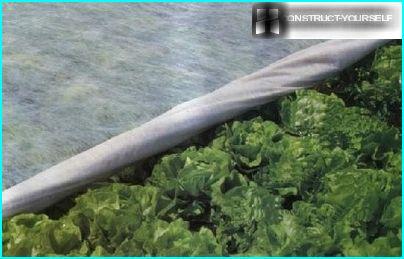
With the help of AGROSALON can protect and aboveground parts of plants. To do this, at the time of cooling is sufficient to cover their canvas
Geotextile – a versatile material, the use of which does not require possession of special skills. Its use greatly simplifies the work in the garden and for landscaping.

